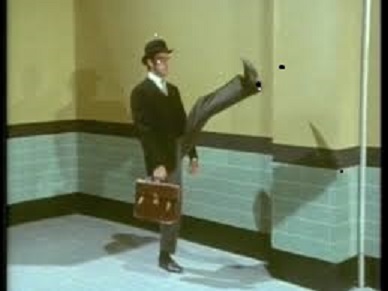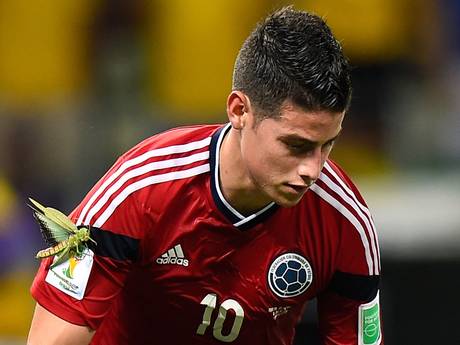|
Is it my imagination, or are penalty kicks getting funkier?
My general impression is that some of the PKs during the knockout round have had some style elements of John Cleese from the Ministry of Silly Walks. Or maybe Monty Python is on my mind because of their farewell performances this month. On Saturday, I watched James Rodriguez of Colombia take the penalty kick against Brazil. He advanced a few steps, stopped, dipped his knee like a page in court, and flicked the ball into the net. (His reward was a visit from a giant grasshopper that alighted on his right arm, looking like it could carry him off.) The Rodriguez dip was not as brazen as the full Panenka performed by Andrea Pirlo in the 2012 Euros against Joe Hart of England. The Panenka is named after the Czechoslovak player, Antonin Panenka, who in 1976 slowed down and nudged the ball airbound for a slow-motion goal that must have taken a second a yard to reach the net. Panenka thereby gained the rare sporting fame of having a technique named after him, something usually reserved for the innovators of figure skating, for goodness’ sakes. But others have been dipping and dodging their way toward the disk where the ball rests. Kostas Mitroglou of Greece did a nice little Grambling Marching Band stutter step before deftly kicking a PK in the first round of the shootout, which Greece lost to Costa Rica, eventually. And Neymar and Cristiano Ronaldo have added a little funky-chicken elbow and knee action to their goal routine. Technically, says my goalkeeping guru Alan Rubin, a player is supposed to progress toward the disk without diversion. Then again, keepers are supposed to stay behind the line, rather than advance on the kicker (remember Brianna Scurry in the 1999 Women’s World Cup?) And Tim Krul of the Netherlands seemed to be imitating Muhammad Ali’s nostril-flaring showboat visit to Joe Frazier’s gym back in the day when he came into the match for the shootout against Costa Rica the other. “I think goalie antics are nothing new,” Duncan Irving, the long-time soccer writer, said in an email message to me. “I saw Holland’s Hans Van Breukelen get up in the grilles, as the kids say, of Danish players at Euro 1992 (the Dutch lost the shootout in the semifinal.) England’s Joe Hart was shouting during Euro 2012 — Pirlo took a Panenka on him “to teach [Hart] a lesson” — and Bruce Grobbelaar (Liverpool) famously performed a jelly-leg goal-line dance against Roma in the 1984 European Cup final.” I am watching the two semifinals to see if anybody tries a backheel PK after doing the Michael Jackson moon walk. Lifetime fame – or infamy -- awaits.
Gene Palumbo
7/7/2014 03:17:54 pm
Column alert: George has a piece in the Times today:
Andy Tansey
7/7/2014 11:59:53 pm
George:
Andy Tansey
7/8/2014 12:21:41 am
P.S. I meant to share!
Josh
7/8/2014 04:37:21 am
It's not just penalty kicks and its not just Monty Python. Free kicks have their own absurd bit of fancy footwork and tie-in to British television comedy.
George Vecsey
7/8/2014 05:17:59 am
Thanks to Andy and Josh. 7/8/2014 09:16:05 am
Andy-it’s nice to have a knowledgeable referee with a sense of humor in the family.
Andy Tansey
7/9/2014 03:52:26 am
Alan:
Ed Martin
7/8/2014 03:41:13 pm
Always fun to read these knowledgeable comments. I am looking forward to hearing you-alls (south Long Island), views on the stunning Germany-Brazil match.
George Vecsey
7/8/2014 04:20:21 pm
Ed, thanks for asking. The NYT has asked me to write early Wednesday for the web. I am churning it overnight.
George Vecsey
7/9/2014 05:37:32 am
Up and Running: My NYT column on the German Plan:
Altenir Silva
7/9/2014 06:17:06 am
Dear George,
George Vecsey
7/9/2014 06:19:43 am
Dear Altenir: I felt terrible for the Brazilian people. They are so nice, the joy of the sport. The images on the screen -- you as a film person know what an image of a child or a grown woman crying can do. And it was spontaneous.
Altenir Silva
7/9/2014 07:51:42 am
Dear George,
Andy Tansey
7/9/2014 06:17:09 am
My compliments on the NYT column. Hope for the USA if it develops the right program and attracts more of the best athletes? I don't think dual citizens are the long-term answer. It is a matter of hard-wiring kids sports instincts with balls at their baby feet. My casual observation suggests there is great hope. I see more and more young families out for days in the parks with a football (the round kind). Spectacular tournaments and their popularity in the next generation of young parents, some of whom played or play, should also help. My elevator screen advises that NYCFC is my new football club. Maybe that will help. Thank you, Etihad and Manchester!
George Vecsey
7/9/2014 06:21:49 am
Andy, depends how one defines short-term, but definitely. For the next four years: Fabian Johnson...who was part of that wave of U-21 players. The long run -- kids who tussle in the park on their own and learn to let loose, not worrying about what Coach or parents say. 7/9/2014 08:32:37 am
George Comments are closed.
|
Categories
All
|











